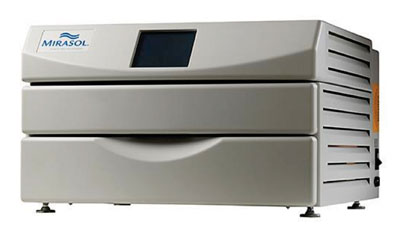Blood Transfusions in Malaria Zones Made Safer
By LabMedica International staff writers
Posted on 03 May 2016
Patients, especially children, who undergo blood transfusions in sub-Saharan Africa, are at high risk of transfusion-transmitted malaria. Every year, approximately 214 million people worldwide are infected with acute malaria, the majority of whom are in Africa and the disease is caused by the parasite Plasmodium.Posted on 03 May 2016
A new trial suggests that treating donated blood with a new technology that combines ultra-violet (UV) radiation and vitamin B is safe and could minimize the risk of malaria infection following blood transfusions. Commonly used procedures for whole blood include nucleic acid testing, blood filtration or bacterial culture, but these are not done in most developing countries because of a lack of resources.

Image: The Mirasol pathogen reduction technology for blood transfusions (Photo courtesy of Terumo BCT).
Scientists at the University of Cambridge (UK) and their colleagues carried out a randomized, double-blind, parallel-group clinical trial of eligible adult patients, aged 18 years or more, with blood group O+, who required up to two whole blood unit transfusions within three days of randomization and were anticipated to remain in hospital for at least three consecutive days after initial transfusion. There were 223 adult patients who needed a blood transfusion because of severe anemia or hemorrhage took part in the study.
The team analyzed blood samples for all of the transfusion recipients on the day of the transfusion and 1, 3, 7 and 28 days later. By studying the sequences of Plasmodium genes present in the blood, they were able to tell whether the patients were likely to be carrying the donor parasite after the transfusion. A total of 65 patients were not previously carrying the parasite, half received parasite treated blood, and the other half received parasite untreated blood. There were 8/37 patients (22%) who received untreated blood later tested positive for malaria parasite, compared 1/28 (4%) of patients who received treated blood.
Treatment of whole blood was with the Mirasol Pathogen Reduction Technology (Terumo BCT, Lakewood, CO, USA). Coagulation parameters, platelet counts and hemostatic status of the patients was similar whether patients received treated or untreated blood. The technology did not appear to affect the coagulation properties of the blood, and patients who received the treated blood had slightly fewer allergic reactions to those who received the untreated blood (5% versus 8%).
Jean-Pierre Allain, MD, a professor and lead author of the study said, “Testing for parasites such as malaria is expensive and until now, there have been no technologies capable of treating whole blood, which is most commonly used in transfusions in sub-Saharan Africa. This is the first study to look at the potential of pathogen-reduction technology in a real-world treatment setting and finds that although the risk of malaria transmission is not completely eliminated, the risk is severely reduced.” The study was published on the April 21, 2016, in the journal the Lancet.
Related Links:
University of Cambridge
Terumo BCT




 assay.jpg)







